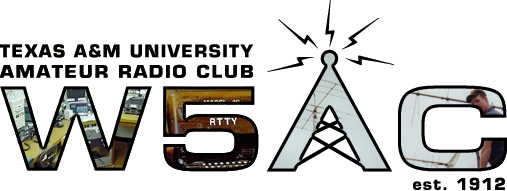



Search:
Callsign lookup:
APRS Locator:
(Type * after callsign for locations that might include a number suffix)
The W5AC shack has recently moved. Our current operating capabilities are not as extensive as listed below and we hope to be back to normal soon. Information on the new shack will be provided as it becomes available.
Click here to see pictures of the shack.
|
| ||||||||||||||||||
Courtesy of John AC5NB - Updated 9/2017
Before powering the radio on, you should connect the RF port to an appropriate antenna (or dummy load). There are presently 3 good feeds on the patch panel for HF operation.
Connect a radio to an antenna (or dummy load) by patching the radio's panel port to the applicable port. Patch cables are kept on a wire hanger on the rack just below the patch panel.
Transceiver feeds:
CAUTION: Be doubly sure not to patch a transceiver to another transceiver. The transmitting radio will destroy the front end of the other radio.
To ensure that the transceiver demonstrates the behavior one would typically expect, you should make the transceiver settings match the "defaults" given below.
These settings are suggested as a starting point. It is up to the control operator to determine the most appropriate settings for the task. For example, 160 m, 80 m, and 40 m voice is customarily LSB, whereas voice on 20 m and up is customarily USB.
When transmitting, it is a good idea to have METER set to POWER to check that the mic gain is a reasonable value. If the gain is about right, the power needle should peak at or above 80% but less than 100%. If it peaks lower, you can increase mic gain. If the METER needle consistently hits the top of the scale, your audio signal is too strong and is overdriving the modulator input. Excessive mic gain will cause distortion in your signal, and it could possibly cause out-of-channel emissions. Too little mic gain is better than too much.
The TS-430S does not have a builtin keyer.
This is an all-mode, full-duplex 2 m and 70 cm transceiver (not fitted with the optional 1240 MHz band module). It is suitable for working linear transponder satellites.
Procedures for this radio will be added at a later date.
After powering on the transceiver and setting initial settings, adjust the volume to a comfortable level, and set mode to either LSB/USB/CW as appropriate. Tune up and down in any band of your choice. If the noise is flat with no other audible signals, try listening on 1 or more other bands. If the symptoms persist, it is likely that the RF energy is not making it from the antenna to the transceiver due to a fault somewhere along the way. Troubleshoot to determine whether there is a real problem and correct it as needed before attempting to transmit.
The following items should be at the operating bench.
Power down the radio. Disconnect RF cable at patch panel between radio and antenna/load. Turn off the main AC power switch on the bench.
The repeater is the club's primary means of on-the-air communication, and is located in the Oceanography and Meteorology (O&M) Building. VHF equipment in the shack includes a Kenwood model TS-711A 2 meter all-mode base station (donated by Donald Foster, Class of '36, KA5OGA) and a Kenwood TS-600 6 meter all-mode base station.
To work satellites, we use a Yaesu FT-726R VHF/UHF all-mode satellite station.
Our UHF (70 cm) radio is a Kenwood TM-441A.
The shack has an AEA PK-232MBX for RTTY, AMTOR, and CW encode/decode (to be used on VHF/UHF). It can run up to 1200 baud, and the MBX designation indicates it has a mailbox feature. It is on loan from Kurt Freiberger WB5BBW. We also have a KAM (Kantronics All-Mode) Terminal Node Controller (TNC). The VHF desk has three different amplifiers, each capable of FM or SSB operation, as well as a Realistic Pro-2005 scanner.
HF gear includes a Kenwood model TS-930S with automatic antenna tuner, a Kenwood TS-940S (donated by Donald Foster, Class of '36, KA5OGA) with automatic antenna tuner, and an Icom IC-751.
For HF we also have Drake and Henry amplifiers, and 2 external antenna tuners. For digital modes (including RTTY and packet), we have a software solution running on a PC on the HF side of the shack.
We now have a NOAA Weather Radio receiver (with alarm) in addition to numerous maps of the area, which may prove useful for Skywarn storm-spotting (or TAMMSSDA stormchasing) in the future. Mike KZ5M has also donated an old television to the shack, so we can keep up with local news broadcasts - just in case. The W5AC shack can be used as a backup communications center if there is an emergency in our area (note from our history that "our area" is pretty big). NOAA Weather Radio also broadcasts Amber Alerts.
The shack has ample desk space, a comfortable couch and an old AM/FM radio for those times when one just can't get good studying done anywhere else.
Our Pentium announcing DX spots on 145.590 MHz, "EGOR," has been dismantled after a nearby lightning strike damaged it.
W5AC has several types of antennas on the roof. Height of the antennas ranges from around 40 feet Above Ground Level (AGL) for the TVRO satellite dish to about 100 feet AGL for the top of the HF tower.
The VHF tower array is pointed in the horizontal plane with a remote rotor.
This array is pointed anywhere in the sky with a Kansas City Tracker, or "KCT", to follow satellites (especially Orbital Satellites Carrying Amateur Radio) automatically.
This array is pointed in the horizontal plane with a remote rotor.
* With this, we can receive and thus rebroadcast NASA Select TV Audio on 2 meters during shuttle missions. However, NASA Select rebroadcasting on 147.540 MHz is inactive for the forseeable future as NASA TV has changed its schedule format. Also, the lightning strike that disabled "EGOR" also damaged the TVRO equipment.